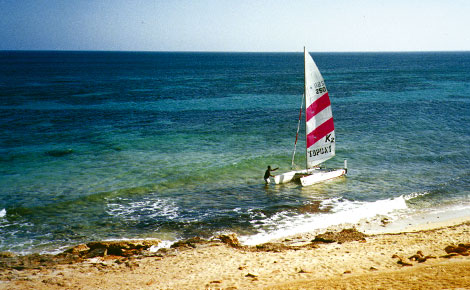- Villa search

- Canaries
- Caribbean
- Croatia, Bulgaria and Hungary
- Cyprus
- Florida
- France and Corsica
- Greece
- Italy
- Lakes and Mountains
- Madeira
- Malta and Gozo
- Portugal
- South Africa
- Spain - Balearics
Related articles
Paradise found (Formentera)
Menorca millionaires… for a week!

The island where life really is a beach
David Kernek can understand why holidaymakers fall in love with Formentera and return year after year
You’ll never guess who I saw in Ibiza Town. It was that Peter Stringfellow fellow, the man who brought table-dancing clubs to Britain, wearing one of his frightening shirts and strolling by the port’s cafés with a young lady on his deeply bronzed arm. Just as well, then, that we were on our way to a sunshine break not in Ibiza’s club zone but on Formentera, a tiny island just a few miles but a world away.
My introduction to the island was a beach-bar dinner party thrown by John Astbury of Astbury Formentera to celebrate his holiday company’s silver anniversary. After a career in the army, John discovered Ibiza in the 1970s, but looked elsewhere when it was also discovered a little later on by the package tour industry. He took the 30-minute boat ride to Formentera and, while commuting to and from a home in England, has never really left.
Building up a portfolio of self-catering beachside studios, apartments and villas – his is the only British rental company specialising in Formentera – he’s spent 25 years helping holidaymakers to share his love affair with the island. For many, it’s an enduring passion; they return again and again.
The island has seen changes during the past quarter of a century, but they haven’t altered its low-key, relaxed character. There are no high-rise hotels, and there isn’t anything resembling an Ibiza-like club scene; our late-night search for music and dance – music, at least, that people over 40 could dance to – wasn’t successful.
Formentera’s quiet, relaxed atmosphere with a gentle hippy undertone (they came here in the 1960s and many stayed) is a major attraction, but the big draw is this little island’s magnificent beaches. There are miles and miles of them, all unspoiled and protected from development; the entire coastal strip is an official nature reserve.
The longest and widest beach – Platja Migjorn – stretches for almost five golden miles along the island’s southern coast from Cap de Barbaria to La Mola. It’s also the best, but it’s rarely if ever crowded.
While strict planning controls protect the fauna and flora (including Marram grass, Phoenician juniper and slightly larger-than-normal sand lizards) that thrive on the dunes, you’re never too far from a discreetly sited restaurant or beach bar for lunch, dinner or, with an early evening cocktail, to simply watch spectacular sunsets.
Where we stayed
Our holiday home for the week was one of the 14 one-bedroom Migjorn Talaya Beach bungalows that’s been added recently to Asbury Formentera’s portfolio. Surrounded by palm trees and hidden in the dunes, it’s a very short walk from both an excellent beachside restaurant and a hotel where services for non-residents include money-changing and use of its two large swimming pools.
Weekly rental rates for Astbury Formentera studios, apartments, bungalows and villas in 2008 range from £232 to £414 – based on two sharing – depending on location and season.
For more details, contact Astbury Formentera.
Tel: 01642 210163
E-mail: astbury@formentera.co.uk
Website: www.formentera.co.uk
Write to: Asbury Formentera, 31 Baker Street,
Middlesbrough, TS1 2LFhome | destinations and editorial | villa search | property for sale | car hire | flights | services
villaseek blog | contact villaseek | links and resources | advertise your villa© Dune Root Ltd and Villaseek.com 2012 - Caribbean
- Canaries